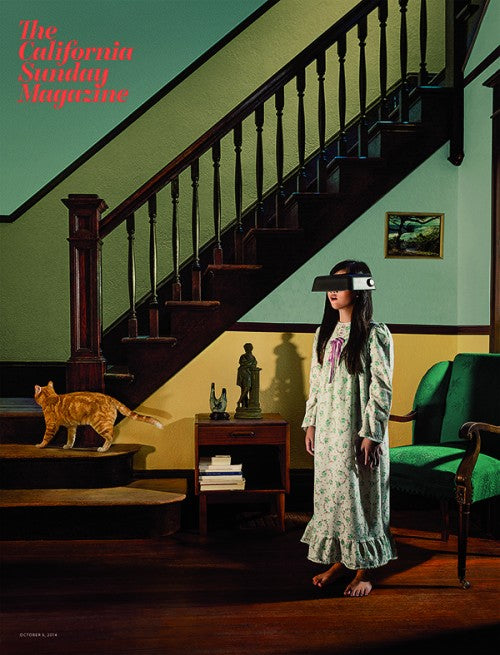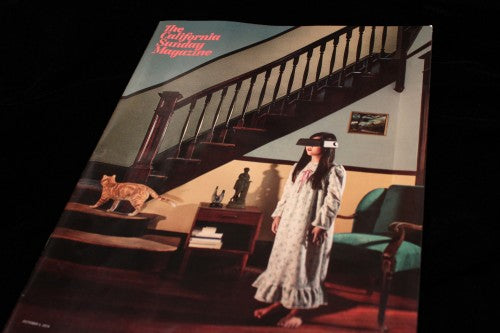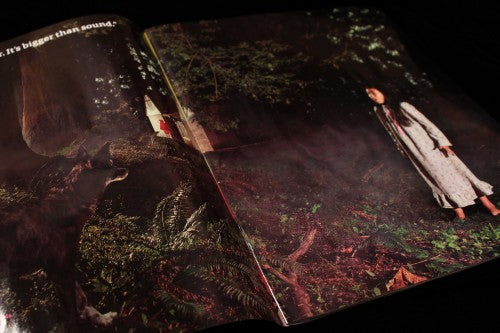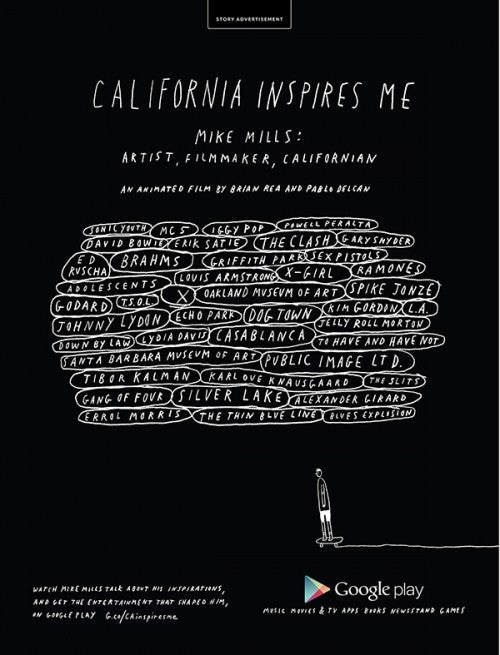
California Sunday launches

California Sunday is a new independent magazine with a lot of unique features. It’s a monthly magazine that will “eventually” become weekly. It’s distributed digitally, and also prints a huge number of copies – all of which are placed as paid inserts inside a handful of Californian broadsheet newspapers. It’s created by a magazine company whose only previous product is a live deconstruction of a magazine. And its creators are a surprisingly small number of people, writes Andrew Losowsky.
I talked to its publisher, Chas Edwards, about business models, unexpected inspirations, and how the heck to get tickets for their elusive Pop Up Magazines.
How has the launch been?
It was a crazy last couple of weeks but it’s really exciting to see it out there in the world. The feedback seems pretty positive. We were happy to find out that people like what we’re doing.
Why California Sunday?
There are a lot of stories here in California that are of national importance. Prior to California Sunday,
What do you mean by that?
You look at a comparable magazine published in another place, and they tend to focus either on stories, meaning the words, or focus on the visual aspect, the artwork or photography in more of a design magazine. California Sunday tries to bring these two together in a magazine that is visually very cinematic, a lot like the place of California.


Will every issue have a two-part cover?
Yes.
Tell me more about your business model.
There are four basic ways that we’re generating revenue. One of them is our events business, Pop Up Magazine, where we sell tickets and have sponsorship. Secondly, we sell digital subscriptions, and thirdly we sell advertising across the digital issue. The fourth is print advertising.
Print advertising in magazines works very well for advertisers, they pay rates that are substantially above what they pay in other media, especially digital. But in order for them to pay attention to a magazine - and I’m talking about folks like Google and Lexus - a magazine needs to reach a critical mass of audience. The way most magazines do it is that you launch, and you spend a few years marketing to a subscriber base. That can often cost as much as $100 per subscriber, and so you’re spending tens of millions of dollars to get to a point where advertisers will take a meeting with you.
Our relationship with the newspapers in California <LA Times, San Francisco Chronicle, Sacramento Bee, and for the launch, New York Times readers in the Bay Area> gave us the ability to reach 400,000 readers with our first issue. It also enabled us to work with the newspapers to select a subset of their audience that we think are most interested in the kinds of stories that we’re going to tell, an audience that most looks like the kind we get at our live events. They tend to be a little younger than the average newspaper reader, they tend to live more in urban areas than outer suburbs, they’re huge media consumers, they work in industries like Hollywood, tech or the media business.
With each of the papers, we selected neighborhood by neighborhood, and in Los Angeles, the magazine was also available in the newsstands of those same neighborhoods.
How easy is it to make a significant amount of money through digital subscriptions?
I think more and more people are exploring digital subscriptions, some with greater success than others, but I think that over time it’s an important part of the revenue mix for any media company. Even right out of the gate, we’ve found that there is a bit of an appetite for fans of our product who want to access our content on different devices.

Tell me about your native advertising studio.
Some of the stories are conventional print ads – we accept those as well. But for certain brands who are interested in speaking to our audience more directly, we work with them through a studio here that is separate from our editorial group.
Conceptually we want to form relationships to create more great stories for our readers.
What are California Sunday’s inspirations?
Too long a list to mention, but maybe another way to answer that question is to talk a little bit about where we come from.
Our creative director is a guy named Leo Jung. He was the deputy art director of the New York Times Magazine for some years, and then he was the design director at Wired magazine. Those are two magazines that we very much admire. My partner in the business and our Editor in Chief here is Doug McGray, he’s worked at some magazines and been a writer over the years for The New Yorker, the NYT Magazine, Wired, Fast Company.
We also look to audio magazines for inspiration. ‘This American Life’ is a place where Doug has produced stories, and some of our other editors have also worked with them. Another of our senior editors comes to us from Radiolab in New York, so the approach of some of the great radio programs have to telling stories is very inspirational to us.

Does that mean that we can expect audio sections to California Sunday stories?
Absolutely. One of the liberating things we learned about producing a magazine live on stage is that we’re not constrained by format. There are times when audio stories can be very well told on digital devices, so adding a soundscape to a story, at least in the digital version, is something that you’ll probably see quite a bit of from us.
We’re really at the very early days of digital platforms. It’s a very exciting time to figure out how to add richness to the stories.
When do you plan to change your frequency from monthly to weekly?
We don’t really know. We want to get the hang of monthly first, make sure that we’ve found our voice, established our rhythm and connected with an audience, and as we get the hang of doing that once a month, we want to increase the frequency and eventually get to weekly.
The West Coast approach to starting companies generally does not start with tens of millions of dollars. You focus on a single product, make it the best product you can and you see how people use that product. Doug and I have both been here in Silicon Valley, in his case covering it, in my case starting some companies, so we’re both very informed by lean company thinking and the Silicon Valley way of building a business, which is to start small, iterate and improve, and then expand from there.
How small are you?
Our staff is fewer than 15 people. We pride ourselves in partnering well with others, so on the technology side we have a very close partnership with The Atavist, on the distribution side we’re partnered with the newspapers, and on the storytelling side we have an enormous network of freelance writers, photographers, illustrators, filmmakers.
Will your live event Pop-Up Magazine be rebranded California Sunday Live?
They’re part of the same company, and we’re a small company. Pop-Up is the live events arm, and we’re not abandoning that name. We’re pretty open about the fact that we’re one media company that publishes two titles: a live magazine called Pop-Up Magazine and California Sunday. There will be more and more overlap between the two brands so the world knows that we’re the same people doing both.
Finally, tickets for Pop Up Magazine sell out in minutes. What’s the secret to successfully getting into an event?
That’s a question that hurts! Pop Up Magazine started as a hobby. And more and more, we were feeling the pain of that - we could only do two a year, and were reliant on the box office software of other places. Now we’re bringing out more shows in more venues, combined with a smarter way of selling tickets, so we hope to be less annoying.
We have two big shows coming up in the fall, one in San Francisco, one in Los Angeles. We can do big shows and small ones, so hopefully more people will get a chance to be there, and fewer people will be turned away at the box office.
------------------------------------------------------------------------------------------------------

California Sunday: A brief review of the print edition.
I like issue one of California Sunday. But I don’t love it.
The two-part cover is fantastic, but the rest of the issue doesn’t quite live up to that medium-pushing start. There’s a decent mix of stories, but I felt that the writing and editing could have been sharper. The design varies between a classy, unsurprising American Sunday magazine and something more ambitious, yet none of it is really gripping or ground breaking except for the cover, and the perfect pacing of the double-photo-spread opening of a piece about a girl who disappeared (above, below).
The overall feel of the magazine seems to me to be overwhelmingly urban, affluent, white, male (there are women in senior masthead positions but the top team is all male) – very much like the world of Silicon Valley, in fact, which is a very particular kind of wealthy California.
This is, of course, only issue one. It’s an interesting start, with a fascinating business model - I’m delighted that it exists. As this talented team gets into its stride and becomes more confident, California Sunday could yet become a must-read, wherever you are. So far, it promises much, and delivers some. I’m intrigued to see what happens next.
Interview and review by Andrew Losowsky.



